Mike Pence Is the First Major 2024 Presidential Candidate to Leave the Race
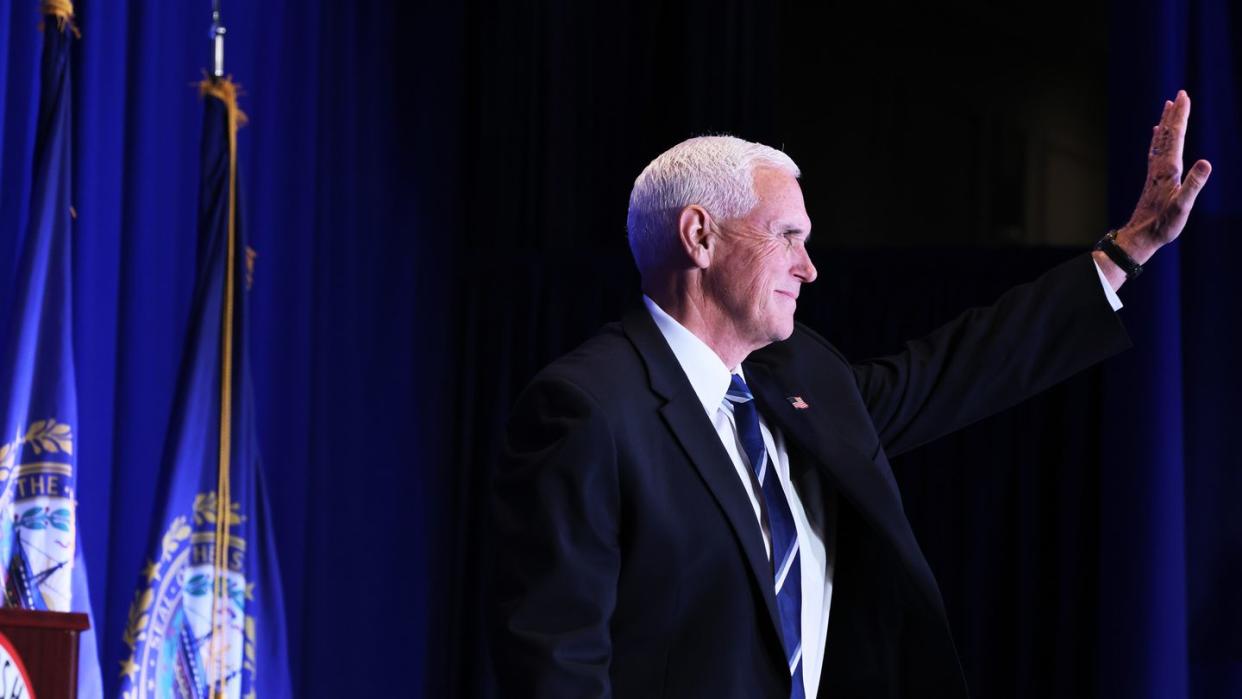
- Oops!Something went wrong.Please try again later.
- Oops!Something went wrong.Please try again later.
- Oops!Something went wrong.Please try again later.
"Hearst Magazines and Yahoo may earn commission or revenue on some items through these links."
1959-present
Mike Pence News: Former Vice President Ends 2024 Presidential Campaign
Nearly five months after launching his presidential campaign, former Vice President Mike Pence called it quits. The 64-year-old made the surprise announcement October 28 at the Republican Jewish Coalition’s annual conference. “I’m leaving this campaign, but let me promise you, I will never leave the fight for conservative values, and I will never stop fighting to elect principled Republican leaders to every office in the land,” said Pence, who is the first major candidate to leave the race. He hasn’t endorsed any Republicans who are still running.
[table-of-contents] stripped
Who Is Mike Pence?
Before his political career took off, former U.S. Vice President Mike Pence was a conservative radio and TV talk show host in the 1990s. After losing two bids for a U.S. congressional seat, he successfully ran for Congress in 2000, rising to the powerful position of Republican conference chairman. In 2012, he was elected governor of Indiana. Named Donald Trump’s running mate in July 2016, Pence served as vice president of the United States for one term, from 2017 until 2021. He unsuccessfully ran for president during the 2024 election, dropping out prior to the Republican primaries.
Quick Facts
FULL NAME: Michael Richard Pence
BORN: June 7, 1959
BIRTHPLACE: Columbus, Indiana
SPOUSE: Karen Pence (1985-present)
CHILDREN: Michael, Charlotte, and Audrey
ASTROLOGICAL SIGN: Gemini
Early Life and Education
Michael Richard Pence was born on June 7, 1959, in Columbus, Indiana. One of six children to Nancy and Edward Pence, a U.S. Army veteran who operated a series of gas stations, Mike was politically influenced by the Irish Catholic leanings of his family. He grew up idolizing former President John F. Kennedy and volunteered for the Bartholomew County Democratic Party as a student at Columbus North High School.
While church had played an important role in Pence’s early family life, he became more deeply religious as a student at Hanover College, where he became a “born-again Evangelical Catholic.” Later, he fully embraced evangelical Christianity and converted.
His college days also saw an evolution of his political ideology. He voted for incumbent Jimmy Carter in the 1980 presidential election but became inspired by Carter’s successor, Ronald Reagan, and the Republican Party. After graduating with a bachelor’s in history in 1981, he moved to Indianapolis in 1983 to attend the Indiana University McKinney School of Law, earning his juris doctor in 1986.
Early Professional Career
Pence went into private practice following his graduation and tried his hand at politics by becoming a precinct committeeman for the Marion County Republican Party. Seeking to make a bigger splash, he ran for Congress in 1988 and 1990, losing both times to Democrat Phil Sharp. However, Pence learned a valuable lesson in defeat; disgusted by his own line of attack ads, he penned an essay in 1991 titled “Confessions of a Negative Campaigner” and vowed to preach a positive message from then on.
Meanwhile, his public profile continued to grow. Pence served as president of the Indiana Policy Review Foundation from 1991 through 1993, before making the leap to radio talk show punditry with The Mike Pence Show. Referring to himself as “Rush Limbaugh on decaf,” Pence was unapologetic in his support of a conservative agenda but was commended for his level-headed manner and willingness to listen to opposing views. His radio show was syndicated in 1994, and he branched out to television as a morning show host the following year, before ending both programs in 1999.
U.S. Congressman
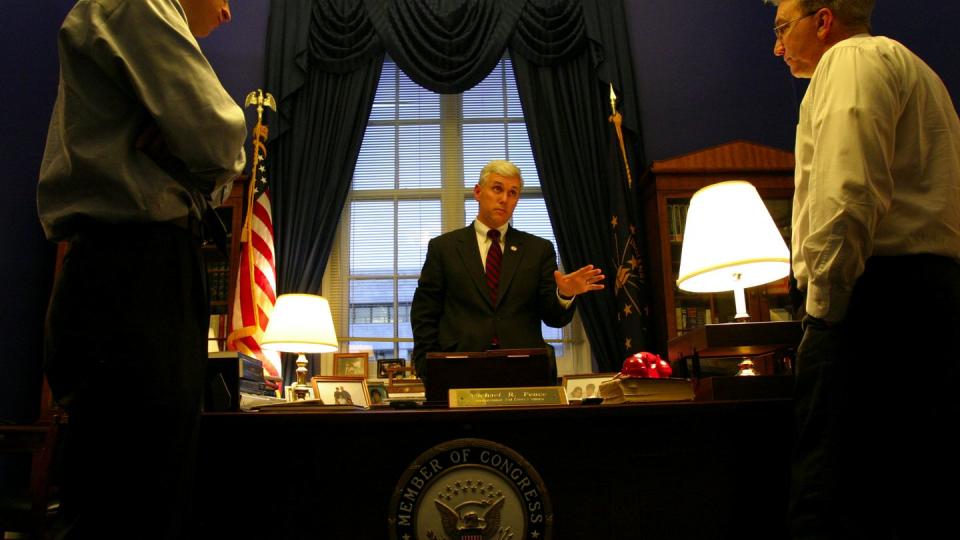
Pence revived his political career by running for Congress again in 2000, this time winning a seat. Describing himself as “a Christian, a conservative, and a Republican, in that order,” he quickly demonstrated that he wasn’t afraid to buck party lines. He opposed President George W. Bush’s No Child Left Behind policy in 2001, as well as the Medicare prescription drug expansion the following year. While his positions rankled party elders, they bolstered his reputation as a man of strong convictions, and he easily won reelection five times.
Climbing the ranks of Republican leadership, Pence was named head of the Republican Study Committee in 2005. He was unsuccessful in his bid to become minority leader in 2006, losing to Ohio’s John Boehner, but two years later, he was unanimously elected to the powerful position of Republican conference chairman.
A staunch fiscal conservative, Pence insisted on cuts to the federal budget before supporting funding for Hurricane Katrina relief efforts in 2005 and was among the leading opponents of the federal bailout in 2008. He also drew attention for his social views, notably supporting a plan to shut down the government over a fight to defund Planned Parenthood in 2011.
Indiana Governor
In 2011, Pence announced his intention to run for governor of Indiana the following year. Despite strong name recognition and a platform focused on tax cuts and job growth, he became embroiled in a heated race with Democrat John Gregg, eventually pulling out a close win with just under 50 percent of the vote.
After he became governor, Pence had his congressional papers, which are housed at Indiana University in Bloomington, sealed. According to the donor agreement, the public is forbidden from seeing many of his papers from the 12 years he served in Congress until his death. (The original agreement stipulated the collection could have been unsealed on December 5, 2022, if Pence were to have died before that date.)
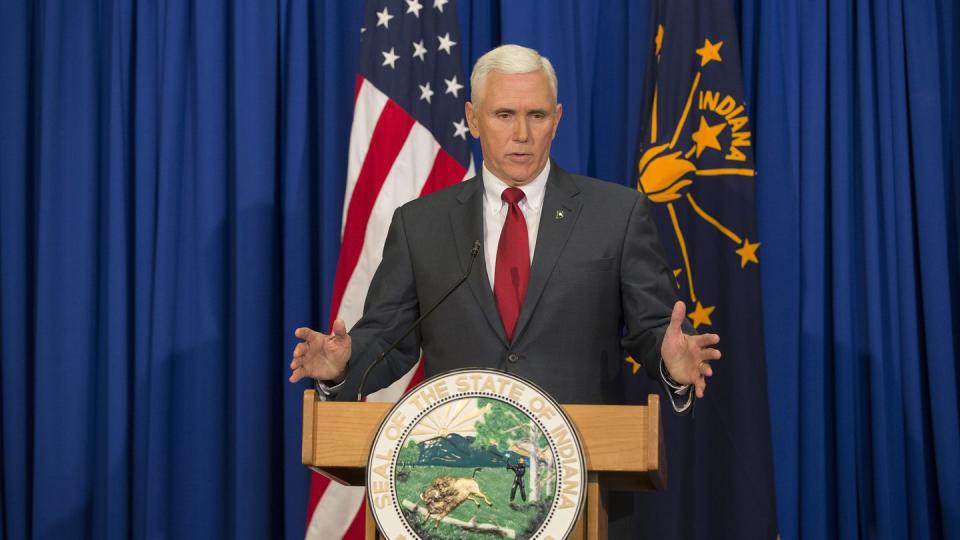
In 2013, Pence signed a $1.1 billion give-back, the largest tax cut in state history. He also signed into law the state’s first pre-K funding program and steered funds toward infrastructure improvements. By 2016, Indiana was enjoying a $2 billion budget surplus and a pristine triple-A credit rating, though critics pointed out that the state’s wages were below national average.
Pence found himself in the national spotlight and on shaky ground after signing the Religious Freedom Restoration Act in March 2015. Intending to protect business owners who didn’t want to participate in same-sex weddings, Pence instead encountered resistance from moderate members of his party and corporations that threatened to pull out of the state, and he was forced to alter the bill to provide exemptions for LGBTQ communities. Similarly, he came under fire in the spring of 2016 for signing a bill to prohibit abortions when the fetus has a disability.
Donald Trump’s Running Mate and 2016 Election
Shortly after announcing his intention to run for a second term as governor, Pence returned to the national spotlight when he surfaced as the vice presidential candidate for likely 2016 Republican nominee Donald Trump. Although Pence had opposed some of Trump’s views, he was believed to be a good running mate for the New York business mogul given his ties to congressional leaders and strong support among conservatives. (Pence had originally endorsed Republican presidential candidate Ted Cruz during the primaries.)
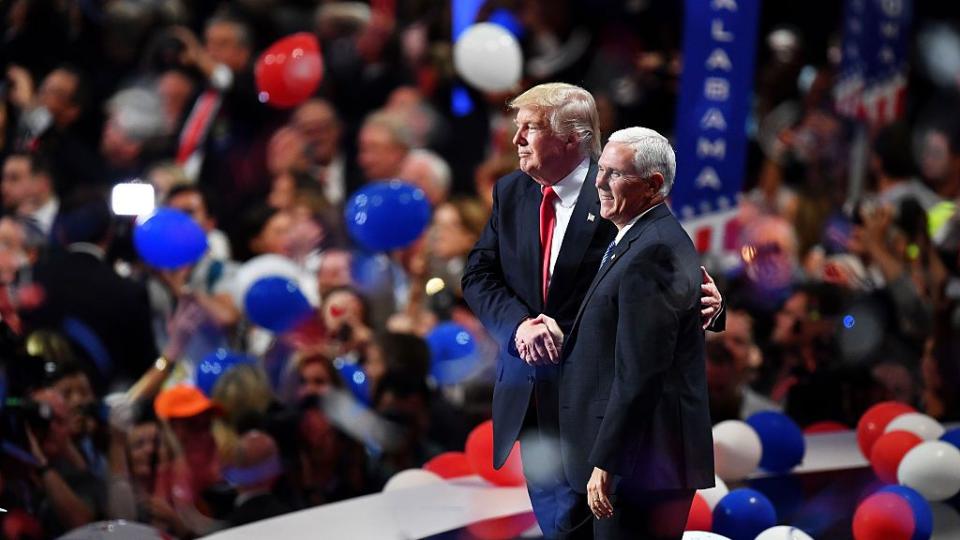
On July 15, 2016, Trump officially announced that Pence was his choice for vice presidential nominee via Twitter. At a press conference a day later, Trump called Pence “a man of honor, character, and honesty.” Days later, Pence accepted his party’s vice presidential nomination at the Republican National Convention in Cleveland. In his acceptance speech, Pence remained composed and spoke of his running mate Trump:
“You know, he’s a man known for a larger personality, a colorful style, and lots of charisma. And so, I guess he was just looking for some balance on the ticket.
“Donald Trump gets it. He’s the genuine article. He’s a doer in a game usually reserved for talkers. And when Donald Trump does his talking, he doesn’t tiptoe around the thousand new rules of political correctness. He’s his own man, distinctly American. Where else would an independent spirit like his find a following than in the land of the free and the home of the brave?”
On November 8, 2016, Pence was elected vice president of the United States when Donald Trump won the presidential race, defeating Democratic candidate Hillary Clinton. The stunning Trump-Pence victory was considered a resounding rejection of establishment politics by blue-collar and working-class Americans.
On November 11, Trump named Pence the head of his transition team, replacing New Jersey Governor Chris Christie. Pence’s office also said he would continue to serve as Indiana governor until his term ended on January 9, 2017.
Back in his home state, Pence found himself in a legal battle to try to conceal the contents of an email sent to him by a political ally. The email was connected with Pence’s decision to have Indiana join other states in suing to block President Barack Obama’s executive actions on immigration. Bill Groth, a Democratic lawyer, sought to have the contents of an attachment to the email made public in an appeal of an earlier court decision in which the Indiana Supreme Court ruled that it was “not for the court to decide” whether to release the emails. Pence’s defense team countered that the contents of the email were protected from being released under the state’s Access to Public Records Act.
U.S. Vice President
On January 20, 2017, Pence was sworn in as U.S. vice president by Supreme Court Justice Clarence Thomas. Pence took the oath of office before Donald Trump was sworn in as the 45th president of the United States. As vice president, Pence cast a historic vote to confirm a Cabinet nominee, led the administration’s COVID-19 pandemic response, backed the president’s agenda, and defended Trump on numerous occasions, including his two impeachments. He also outlined the administration’s plans to create a sixth branch of the U.S. military, the Space Force.
Pence was said to have fostered strong relationships with the men who preceded him in the executive branch, conversing with former Vice President Joe Biden at least once per month and also meeting with Bush’s former second-in-command, Dick Cheney, to exchange ideas and solicit advice.
Betsy DeVos Confirmation Vote
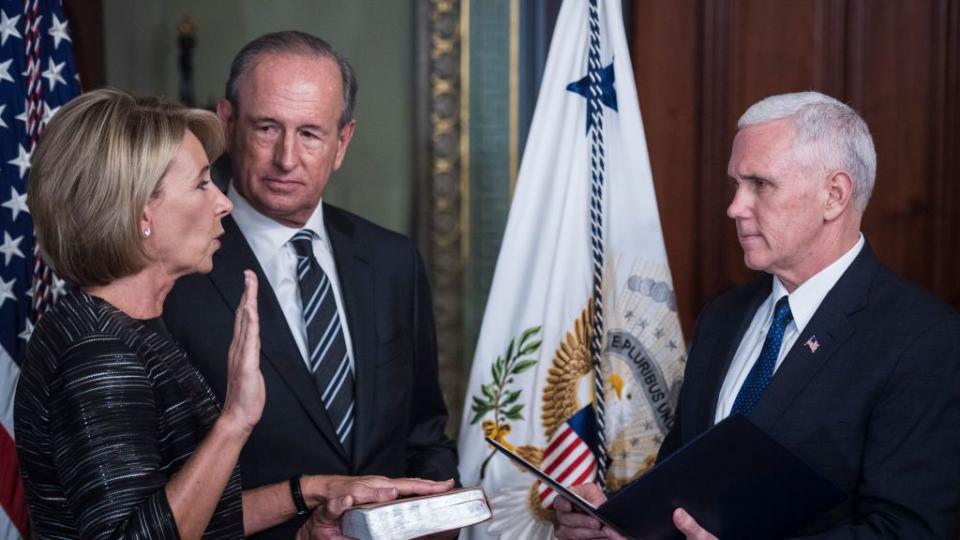
Pence played an important role in the confirmation of Betsy DeVos, President Trump’s nominee for education secretary. Amid protests from Democratic critics and teachers unions that DeVos, a billionaire charter school supporter with no public school experience, was unqualified for the position, the Senate deadlocked in a 50-50 tie. On February 7, 2017, Pence cast the historic tie-breaking vote to confirm her, the first time a vice president has been called on to break a tie in a cabinet nomination.
Michael Flynn Controversy
A week later, it was revealed that another Trump appointee, National Security Adviser Michael Flynn, had misled Vice President Pence about his conversations with Sergey Kislyak, the Russian ambassador to the United States, prior to the inauguration.
According to The Washington Post, Flynn “privately discussed U.S. sanctions against Russia with that country’s ambassador to the United States during the month before President Trump took office, contrary to public assertions by Trump officials.” Vice President Pence had appeared on CBS News’ Face the Nation stating that Flynn had told him that he and Kislyak “did not discuss anything having to do with the United States’ decision to expel diplomats or impose censure against Russia.”
Flynn resigned on February 13, 2017, after less than one month on the job, and in his letter of resignation he wrote: “Unfortunately, because of the fast pace of events, I inadvertently briefed the vice president-elect and others with incomplete information regarding my phone calls with the Russian ambassador.”
Foreign Affairs
Early on in the Trump administration, the vice president defended the controversial rollout of President Trump’s executive order to ban immigrants from the predominantly Muslim countries of Iraq, Syria, Iran, Sudan, Libya, Somalia, and Yemen for at least 90 days, temporarily suspend the entry of refugees for 120 days, and bar Syrian refugees indefinitely.
In January 2018, weeks after President Trump raised an outcry by announcing his recognition of Jerusalem as Israel’s capital, Pence visited the region. Much of his trip focused on working with U.S. partners to counter terrorism and helping Christian minorities in the Middle East, though he also attempted to smooth over things with Arab leaders. That aspect didn’t work out as well, as Pence and King Abdullah II of Jordan publicly “agreed to disagree” over the decision to recognize Jerusalem, while Palestinian President Mahmoud Abbas refused to even meet with the American vice president.
Among Pence’s other trips abroad were a December 2017 visit to Afghanistan, where he met with Afghan officials and U.S. troops, and an October 2019 stop in Turkey with U.S. Secretary of State Mike Pompeo. There, they successfully brokered an arrangement with President Recep Tayyip Erdogan to allow the safe passage of Kurdish forces from an area in northeastern Syria under fire from a Turkish military operation.
Trump’s Impeachments
In fall 2019, Pence was dragged into the House of Representatives impeachment inquiry of President Trump after The Washington Post reported that the vice president was involved in efforts to pressure Ukraine into investigating then–presidential candidate Joe Biden. Pence denied knowing anything about such an attempt and said he didn’t discuss Biden in his communications with Ukrainian President Volodymyr Zelenskyy. He also defended Trump’s behavior at the center of the inquiry, saying it was “worth looking into” Hunter Biden’s business ties to Ukraine when his father was serving as the Obama administration’s policy lead in the country. Top House Democrats requested Pence share documents that could be helpful in their inquiry, though he declined to do so. Trump was impeached by the House that December, but the Senate vote to acquit in February 2020.
Less than a year later, in January 2021, the House again targeted President Trump for his involvement in the January 6 riot at the U.S. Capitol. The Democratic-led chamber passed a resolution urging Pence to invoke the 25th Amendment to remove the president from office. However, in a letter to House Speaker Nancy Pelosi, the vice president declined, writing “I do not believe that such a course of action is in the best interest of our Nation or consistent with our Constitution.” On January 13, Trump was impeached for the second time; a month later, the Senate once again acquitted him.
COVID-19 Response
In February 2020, President Trump announced that Vice President Pence would lead the administration’s response to the coronavirus, which originated in China and was spreading around the world. Citing his experience with the emergence of Middle East Respiratory Syndrome (MERS) as Indiana governor, Pence stressed the importance of partnerships between state and local governments and health authorities when responding to infectious diseases and said he would determine the “best options for action to see to the safety and well-being and health of the American people.”
While his regularly scheduled press briefings were soon dominated by the presence of Trump, Pence focused on delivering measured versions of the president’s fluctuating pronouncements, coordinating efforts with governors and addressing matters of supply shortages. On March 9, he announced that testing capabilities had increased to the point where 5 million tests would be distributed by the end of that week. Two days after the announcement, the World Health Organization officially declared COVID-19 a pandemic.
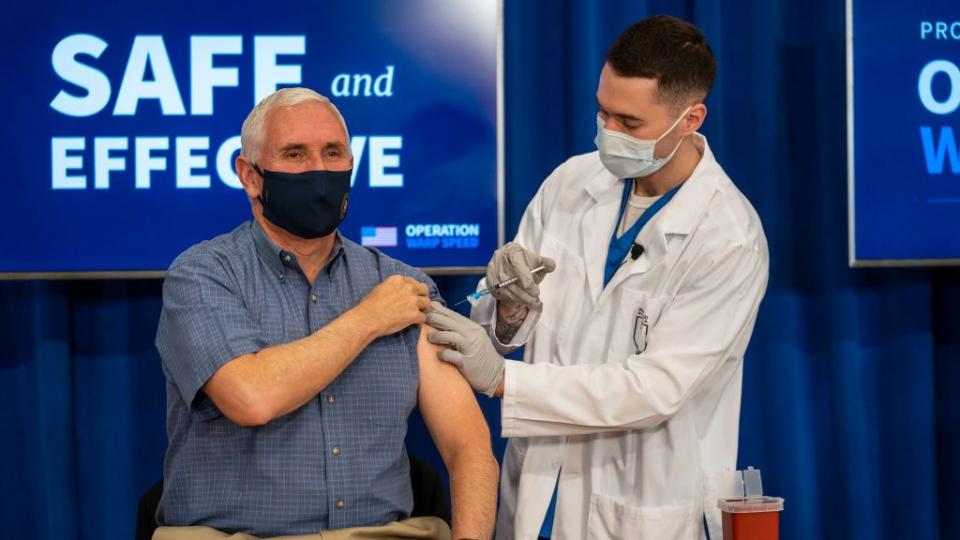
With the administration looking to find ways to reopen businesses and schools by April, the vice president raised eyebrows by visiting the Mayo Clinic in Minnesota without a face mask late in the month, saying he wanted to be able to look workers in the eye and thank them without being obstructed.
During the vice presidential debate on October 7, Pence faced tough questioning from moderator Susan Page and attacks from opponent Kamala Harris over the White House’s response to the coronavirus pandemic that had already killed more than 210,000 Americans. The vice president defended the administration’s efforts, pointing to Trump’s early decision to suspend travel from China and promised that a vaccine would be ready in record time. (That December, the Food and Drug Administration authorized the emergency use of the first COVID-19 vaccine, which began immediate distribution.)
2020 Trump-Pence Election Defeat and January 6 Capitol Attack
In June 2020, President Trump formally announced his much-anticipated reelection campaign with Pence once again on the ticket. Although the vice president expressed confidence in a repeat victory, the days-long effort to count the ballots brought increasingly grim news for the incumbents, until Joe Biden was declared as the president-elect on November 7.
While Trump raged against the outcome and launched a flurry of lawsuits to challenge the results, Pence offered a more grounded perspective of the proceedings, urging supporters to “remain vigilant” as the litigation played out. On December 14, all 538 electors in the Electoral College cast their vote, formalizing Biden’s victory with 306 votes to Trump’s 232.
Trump continued to insist that he won the election, and he called on Pence, as president of the Senate, to reject the results of contested states when Congress convened to formalize the Electoral College vote on January 6, 2021. However, Pence publicly broke with Trump just before the start of the congressional meeting by issuing a letter which read: “It is my considered judgment that my oath to support and defend the Constitution constrains me from claiming unilateral authority to determine which electoral votes should be counted and which should not.”
That afternoon, after the president held a rally in which he criticized his vice president and the “weak Republicans” who refused to join his cause, Pence was among the lawmakers who were whisked to safety when a mob broke into the Capitol and clashed with police, resulting in four deaths and the declaration of a public emergency by Washington Mayor Muriel Bowser.
“To those who wreaked havoc in our Capitol today, you did not win,” Pence said when order was restored. “Violence never wins. Freedom wins. And this is still the people’s house.” He went on to formally declare Biden’s victory just after 3:40 a.m. on January 7.
Life After the Vice Presidency: Book and Classified Document Scandal
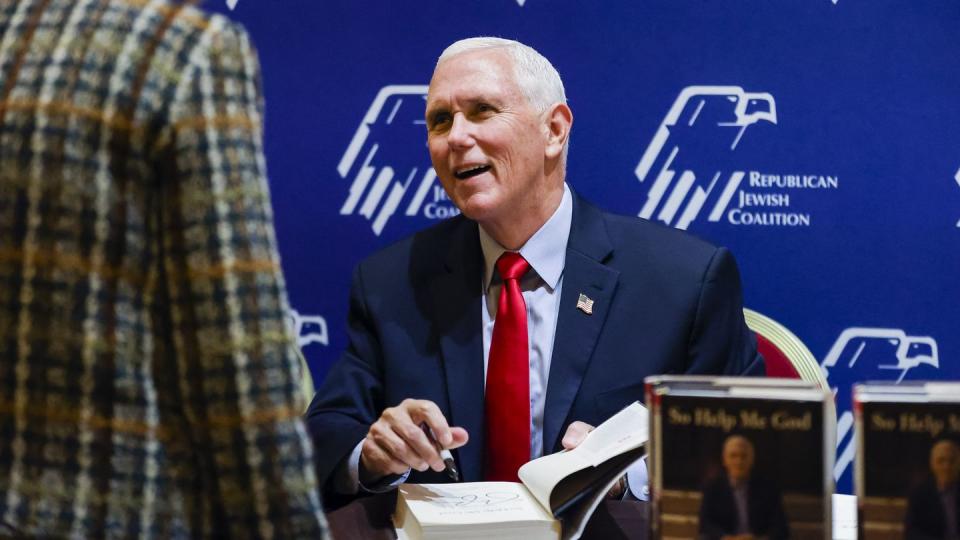
After his term as vice president, Pence signed a multimillion dollar, two-book deal with Simon & Schuster. His first book titled So Help Me God released in November 2022. In the memoir, Pence recounts experiences throughout the Trump administration, including the January 6 insurrection, and defining moments earlier in his life.
In January 2023, Pence became the third high-profile politician to have classified documents in his possession. After earlier news reports that Presidents Donald Trump and Joe Biden had similar material, Pence had a lawyer search his home out of an abundance of caution on January 16. The “small number” of classified documents found were turned over to the FBI, and other government records were returned to the National Archives and Records Administration. Afterward, Pence said, “Mistakes were made, and I take full responsibility.” A subsequent U.S. Justice Department investigation closed its investigation without filing charges.
2024 Presidential Campaign
Pence officially declared his 2024 presidential bid on June 5, 2023. He kicked off his campaign in Des Moines, Iowa, two days later. Presenting himself as a traditional conservative, Pence highlighted the need for a balanced federal budget and spoke in support of helping America’s allies, such as Ukraine and Israel. He also backed a minimum 15-week national abortion ban.
Despite his high profile and previous experience as vice president, Pence struggled to build a strong base of supporters. He participated in the first two Republican primary debates, but poor polling numbers suggested he might not have made the cut for the third one. Instead, Pence became the first major candidate of either party to suspend his presidential campaign in late October, three months before the Republican primaries began.
“The only thing that would have been harder than coming up short would have been if we’d never tried at all,” he said during his October 28 announcement. “To the American people, I say this is not my time.” He also said:
“I urge all my fellow Republicans here, give our country a Republican standard-bearer that will, as Lincoln said, appeal to the better angels of our nature, and not only lead us to victory, but lead our nation with civility back to the time-honored principles that have always made America strong and prosperous and free.”
Wife and Children
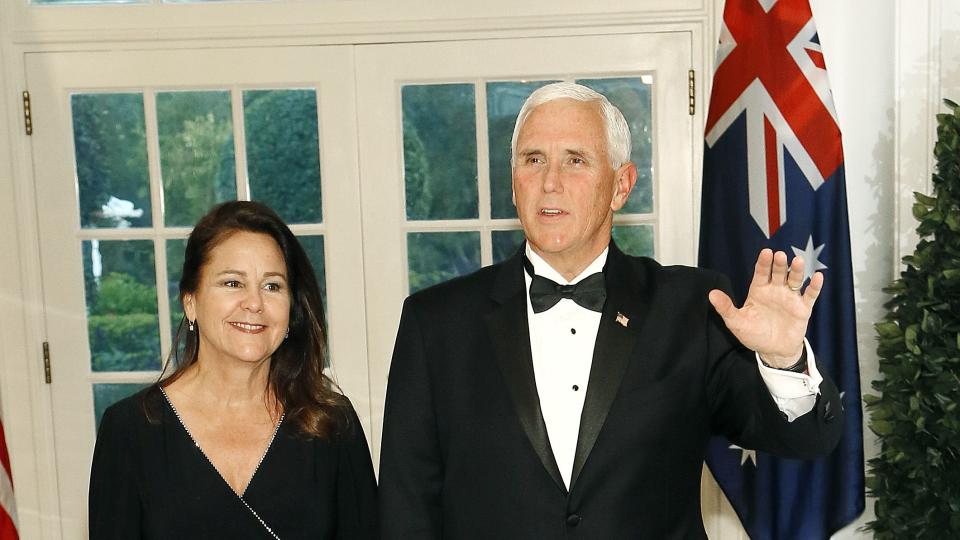
Pence has been married to Karen Pence, whom he met in the early 1980s, since 1985. A former elementary school teacher, Karen has been involved with youth-related nonprofit organizations. The couple has three adult children: Michael, Charlotte, and Audrey. In May 2021, they purchased a home in Carmel, Indiana, just north of Indianapolis.
Fact Check: We strive for accuracy and fairness. If you see something that doesn’t look right, contact us!
You Might Also Like

